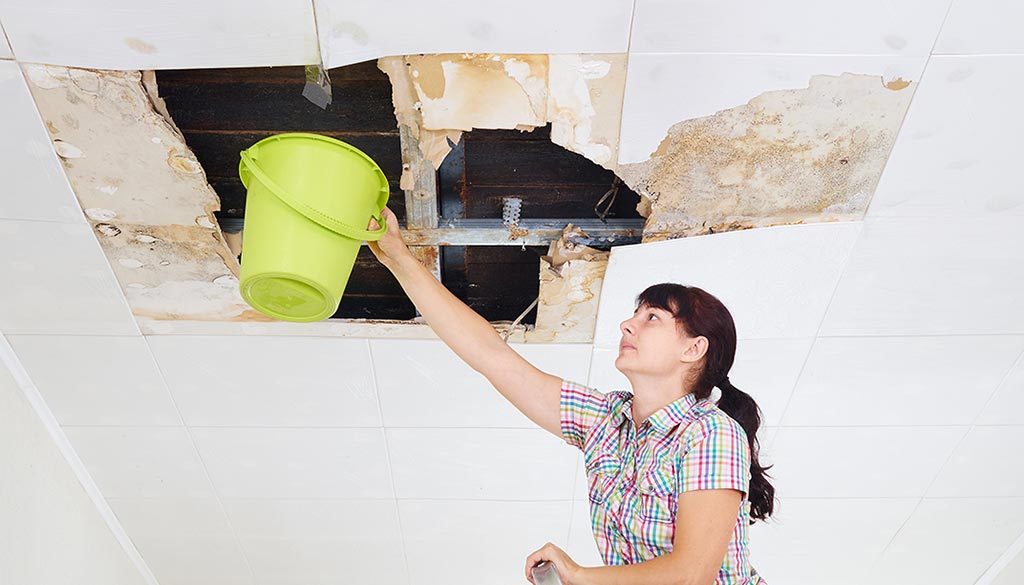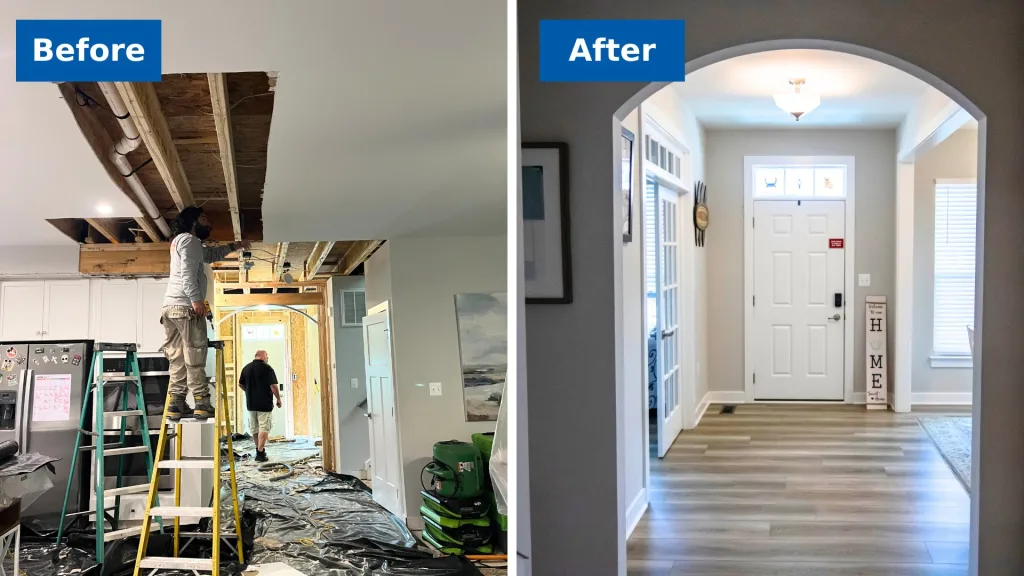Flood Damage Restoration Timeline: What to Expect from Start to Finish
Necessary Actions to Comply With for Efficient Water Damage Remediation in your house
When confronted with water damage in your house, recognizing the vital steps for effective repair can make all the difference. You require to examine the damage and warranty security before dealing with the problem. Quiting the source of water is crucial, however it's simply the beginning. Once you've taken care of that, there's a series of activities you should require to safeguard your residential property from further concerns. Allow's discover what you ought to do following.
Assess the Damage
The initial action is to evaluate the damage extensively when you uncover water damage in your home. Begin by identifying the resource of the water intrusion. Inspect for leakages, burst pipelines, or other concerns triggering the trouble. Next, take a look at the influenced areas for noticeable indicators of damage, including mold and mildew, staining, or bending development. Do not neglect to search in surprise spots like behind walls or under flooring, as water can permeate right into these locations unnoticed.Document the damage by taking clear photos and notes. When reviewing the scenario with your insurance policy provider or remediation experts, this will assist you. Focus on the type of materials affected, as different materials require different restoration approaches. Lastly, examine the degree of the damages. Is it minor or comprehensive? Recognizing the extent will direct you in deciding whether to handle it yourself or contact the experts for an extra comprehensive restoration process.

Make sure Security
Prior to you start any restoration job, assuring your security is important. Analyze the problem of your home. If the water's deep or if you discover electric risks, do not enter the area. Shut off the electrical power and gas supply to stop mishaps. Use safety equipment like boots, gloves, and masks to protect yourself from pollutants or mold.It's crucial to remain knowledgeable about your environments; look for sharp items and unsafe surfaces. If the water is from a sewage backup, treat it as contaminated materials. Maintain animals and children away from impacted locations to prevent exposure.Once you have actually taken these safety measures, you can continue with the repair procedure. Remember, your safety and security precedes, and if you're ever before unsure, it's finest to get in touch with a professional. Taking these actions will certainly aid assure you prepare to tackle the repair safely and properly.
Quit the Source of Water
After ensuring your safety and security, the next action is to quit the source of water. Recognize where the leak is originating from. Maybe a burst pipe, a malfunctioning home appliance, and even heavy rain getting in with a damaged roofing. If it's a plumbing issue, shut off the major water system to your home to avoid further flooding. For appliances, unplug them and shut down their water supply valves.If the source is outside, like rain, try to divert it far from your home making use of sandbags or other obstacles. For small leakages, you could be able to use tape or a sealant temporarily until a professional can repair it. Remember, resolving the source rapidly is vital to minimizing damages and avoiding mold and mildew development. Once you've stopped the water, you'll be in a much better setting to relocate on to the next actions in the repair process.

Get Rid Of Excess Water
Act quickly to remove excess water, as standing water can bring about much more extensive damage and mold and mildew development. Initially, gather your devices: a wet/dry vacuum, pails, and towels. You can use towels to soak up the wetness if the water is superficial. For deeper water, a wet/dry vacuum is your finest bet. See to it to clear the vacuum cleaner regularly to avoid overflow.If the water is polluted, like from a sewage back-up, put on protective gear, including masks and gloves, to maintain yourself safe. Once you have actually eliminated as much water as possible, look for hidden pockets of moisture in corners and under furniture, as these can nurture mold.Don' t forget to turn off electric appliances and power electrical outlets in wet areas to stop threats. This first action is crucial in lessening damages and establishing the stage for an effective restoration procedure.
Dry and Dehumidify the Location
When you have actually gotten rid of the excess water, it's vital to completely dry and dehumidify the location completely. Beginning by making use of dehumidifiers successfully to pull dampness out of the air and avoid mold and mildew growth. Maintain an eye on moisture levels to guarantee the space dries out totally.
Eliminate Standing Water
To effectively take on water damage, you require to focus on removing standing water as swiftly as feasible. Beginning by collecting necessary devices, like a wet/dry vacuum cleaner or a pump, relying on the volume of water. If the water is shallow, a vacuum cleaner must work. For larger quantities, a pump is a lot more efficient. While working, make try here certain to wear protective equipment to keep yourself safe from impurities. As you remove the water, focus on concealed areas like under furniture or in edges where water may gather. Your area will certainly start to dry out once you have actually gotten rid of the majority. This action is vital, as sticking around water can lead to mold and mildew development and more substantial damage.
Usage Dehumidifiers Properly
Just how can you effectively make use of dehumidifiers to completely dry and evaporate your room? Start by positioning your dehumidifier in one of the most afflicted area, preferably where water damages is most serious. Make certain to close all doors and home windows to develop a closed atmosphere. Switch on the dehumidifier and established it to the suitable moisture level, generally around 30-50%. Empty the water collection tank regularly, or think about using a model with a continual drain choice for ease. Ideally, make use of fans to boost air flow, helping the dehumidifier job more effectively. Keep the dehumidifier running until you're positive that the location is thoroughly dried out, avoiding mold growth and additional damages (Smoke Damage Restoration). This step is necessary for effective water damage restoration
Screen Humidity Degrees
Tracking humidity degrees is crucial throughout the drying out process, as it helps ensure your area continues to be complimentary from excess moisture. Buy a trusted hygrometer to track moisture accurately. Ideally, you want to preserve degrees in between 30% and 50%. You might require to change your followers or dehumidifiers to boost airflow if humidity readings rise above this range. Check the readings on a regular basis, specifically in locations vulnerable to dampness, like basements or bathrooms. If you see relentless high moisture, take into consideration increasing ventilation or making use of added dehumidifiers. Remaining on top of these levels not just quickens the drying out process but also avoids mold growth, guaranteeing your home keeps comfortable and secure.
Tidy and Disinfect Affected Surfaces

Recover and Repair Your Home
After cleaning and decontaminating the impacted areas, it's time to recover and fix your home. Begin by assessing the damage. Examine for architectural issues, like weakened floorings or walls, and address any kind of required repair work. Changing damaged drywall or floor covering is vital for both aesthetic appeals and safety.If your furniture or items were impacted, take into consideration whether they can be restored or require replacement. Tidy or expertly recover products where possible.Next, paint walls and touch up any type of locations that need focus. This not only boosts appearance but additionally safeguards surface areas from future water damage.Don' t fail to remember to examine your pipes and appliances for leakages, guaranteeing whatever's functioning properly. Think about installing a dehumidifier to prevent future moisture concerns. By taking these actions, you'll recover your home to its former magnificence and develop a much safer living environment.
Frequently Asked Concerns
Just How Long Does Water Damage Restoration Typically Take?
Water damages restoration normally takes anywhere from a few days to a number of weeks, relying on the level of the damages (Water Damage Repair). You'll wish to examine the circumstance quickly to minimize more issues and guarantee correct repair
Will My Insurance Policy Cover Water Damage Remediation Expenses?
Your insurance coverage may cover water damages remediation expenses, but it relies on your plan. Examine your insurance coverage details and contact your insurance policy agent to clarify what's included and what you need to file an insurance claim.
Can I Handle Water Damages Restoration Myself?
You can take care of water damages restoration yourself, but it's vital to analyze the circumstance initially. If it's comprehensive, you might intend to call experts. Always focus on security and assure you have actually obtained the right devices.
What Are the Indications of Hidden Water Damage?
You may observe indications of hidden water damage like deformed walls, mildewy odors, or staining. If your floors really feel spongy or you place Your Domain Name mold and mildew, it's time to investigate further before the situation gets worse.
Just How Can I Stop Future Water Damages in My Home?
To avoid future water damage in your home, you need to consistently examine pipes, seal fractures, maintain rain gutters, and warranty proper drainage. Setting up a sump pump and dampness obstacles can also help keep your area completely dry. When you uncover water damages in your home, the first action is to evaluate the damage thoroughly. Act rapidly to eliminate excess water, as standing water can lead to a lot more considerable damage and mold and mildew development. To efficiently tackle water damage, you need to focus on removing standing water as rapidly as possible. As you get rid of the water, pay focus to concealed locations like under furniture or in corners where water might accumulate. Water damages remediation normally takes anywhere from a few days to numerous weeks, depending on the extent of the damage.